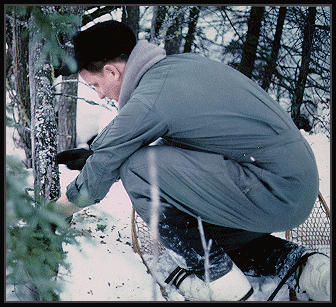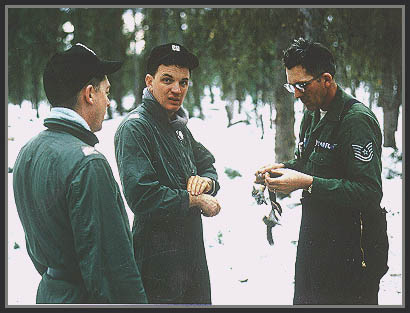
| Firebird crew members were required to attend a three day Arctic Survival school near Fairbanks, Alaska. In this photo Bob Davis, Firebird Navigator, sets a "snare to catch a hare." | |
The Firebirds had been flying in the Arctic for several years when the squadron was moved to Elemendorf AFB, Alaska, in 1964. True to timely official United States Air Force policy, the decision was made that all Firebird crews must attend a three day Arctic survival course if they were to fly in Alaska. After a day of indoctrination, crew members were told that they would be transported to a remote area of Eielson AFB and left for two days. Each individual would be given a sleeping bag, two or three pemmican bars, and a canteen of water. The team would also be given one-half of a parachute, snare wire, and a survival rifle to pursue game. The night before the winter camp-out was to begin, the Firebird crew members met in the Officer's Club to discuss appropriate strategy in order for us to survive. A few "Birds" decided to test the hypothesis that alcohol was not conducive to survival in freezing temperatures. After listening to all of the possibilities, I decided to take a hike over to the Base Exchange and fill my flight suit pockets with Hershey's chocolate bars. The big ones! All of the other Firebirds laughed at my survival kit and let me know that the instructors were sure to find any such contraband. One intelligent thing that the group did decide to do was to purchase ski masks, which kept one's face from freezing at night. On the morning of the trek, we were loaded onto busses and driven to the training area. Everyone was amazed that we were not subjected to body searches…and I was elated. Upon arrival at the site, it was obvious that many other crews had been brought to the same wooded area in previous months. The chances of finding any wild game seemed remote, and after scouting the area, this became reality. There were no foot prints and no animals to be seen. Hunting was out. | |
 |
Bob Davis and Joe Reed don't seem too excited about the prospect of having to eat the squirrel that the arctic survival instructor is skinning. They must not "hail" from a squirrel eating part of the country.
Editor's Note: It appears that Bob is already checking his pulse to see if he is still alive. Photo by Roy Jared, Firebird Pilot |
| Since game was not available, when meal time came around the Firebirds were looking forward to a warm meal of pemmican and a few sips of the precious water to wash it down. Everyone got out his bars, shaved them down with a survival knife, and warmed the mush over a small fire. Then, someone tasted our survival stew. Immediately, I became the popular camper. Chocolate tastes around ten zillion times better than fried, boiled, baked, stewed, or fricasseed pemmican. One "Bird" did finally find a way to eat the "sawdust and axle grease." He found a piece of wood, coated it with pemmican, and baked it slowly over the fire. When the concoction was done, he scraped the pemmican off, threw it away, and ate the timber. At least that's what he told the rest of us.
The temperature during the school hovered around eighteen degrees. Since we knew that it would be colder at night, we piled up boughs in our makeshift lean-to's to keep our sleeping bags out of the snow and dry. The bags were designed to keep one warm when the outside temperature was several degrees below zero, but in reality they just kept the occupant from freezing and not very comfortable. Of course, they never said that one would be comfortable only survive. On the second day, the instructors brought out a large chunk of moose for the survivalists to sample. After coating the meat with all of our onion powder, wrapping it in foil, and baking for a few hours, we were anticipating a delicious wild roast. After a few bites, most of us decided that baked mule would taste about the same. It was back to the chocolate bars once again. Regardless of what the Firebirds thought, the Arctic survival training must have been useful. To date, not a single crew member has been lost as a result of having to survive in the Arctic wilderness. (Nolan Bailey, Firebird Pilot, 1963-67) |
| Editor's Note: Additional stories or corrections relating to the Eielson Arctic Survival School are welcomed and will be added when received. |